Indiana Jones: The Atari Years
Raiders of the Lost Ark
Atari, 1982
The first ever game adaptation of a film (although not the first ever film-tie-in), Raiders of the Lost Ark is a top-down Atari adventure game in the style of Adventure, which essentially invented the genre a year earlier. It’s also similar to the E.T. movie tie-in released soon after Raiders from the same developer, but which was famously the biggest failure of a video game, perhaps ever. A more familiar touchpoint in a similar vein might be The Legend of Zelda, which would come later in 1986 on the Nintendo Entertainment System.
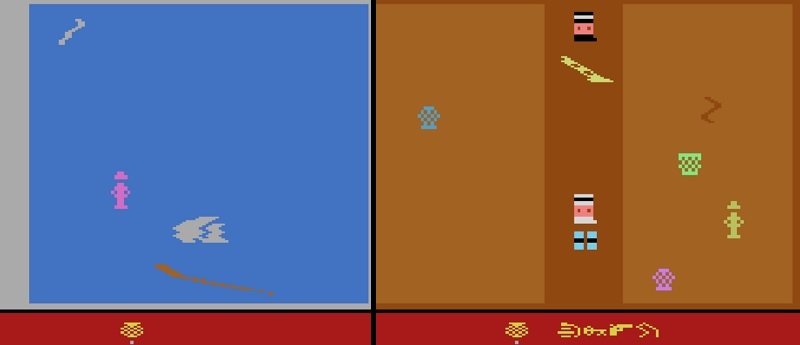
While these games were a whole new world at the time, it’s basically impossible to tell what anything is. Without a manual to tell you what the objects represent it’s just a case of best guess and wandering around until you can take a stab at what you’re supposed to do. Some of what you do is: picking up unknown objects, getting chased, falling, sinking in mud, getting frozen when attacked by flies. Not hugely enjoyable. The manual does give many hints though, and according to Wikipedia the developer would later regret being so reticent to include help for the player. There seems to be a fine line between ‘challenging’ and ‘annoying’.
Although it makes less of a difference when emulating classic games like this, the controls are still frustrating. A rudimentary inventory system, possibly the first in video games, is controlled with a second joystick, with movement on the other. Fumbling around with the inventory reminds me of the awkward inventory in the later Fate of Atlantis: The Action Game. Not at all intuitive and more often than not you fail to do what you intended.
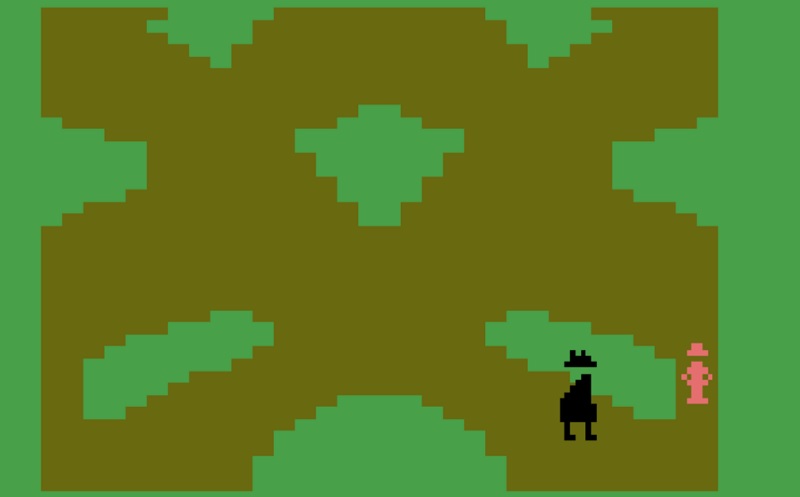
As with a lot of games of the period, the solutions to the puzzles are rather esoteric and require a different way of thinking than modern games. There are a lot of things you must do but as a player there is no ‘why’ to it. A walkthrough contains a good example of game logic in how to get the medallion, a critical item which is not listed in the game manual:
Once you've got all three items from the baskets, wait for about fifteen seconds and check all three again (the snake will be after you so be careful). The medallion should appear in one of the baskets and will be added to your inventory. If not, wait another 10-15 seconds and try again. Repeat until you finally get it.
Moving around the map relatively freely is a positive, but I reached my limit quite quickly after slogging around the various screens,The Temple of Doom Atari game was a lot more playable.
Indiana Jones and the Temple of Doom
Atari, 1985
Originally an arcade game and then ported to home consoles, Temple of Doom is much easier on the eye than the Raiders release three years earlier. The bulk of the game is spent releasing children from captivity much like you did as Michael Jackson in the Sega Mega Drive version of Moonwalker (1990). In between these levels are minecart segments which are actually rather fun, followed by a mini boss fight as you steal a Sankara stone from Mola Ram. Once you have three Sankara stones the boss fight proper ensues. It’s quite a nice loose re-enactment of the movie, supported with bizarre sounding synthesised voices, a first for the Atari.
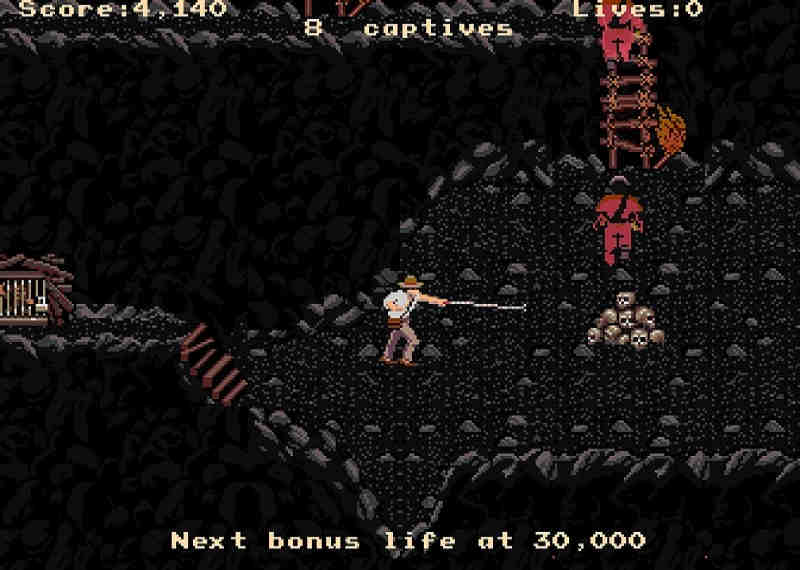
Each level increases in difficulty not by punishing the player with enemies that are faster or take more damage, but by becoming bigger and more complex with new hazards, keeping it fresh and interesting. It’s surprisingly enjoyable, much better than the Last Crusade and Fate of Atlantis action games that came many years later. That is if you play the Amiga version. The PC version is slow with poor graphics and the effort that went into pushing the boundaries of game SFX at the time is wasted. Worse, on PC it’s slow and unresponsive, making it a much worse experience especially for combat.
The 1988 NES port of Temple of Doom meanwhile, differs slightly with the same basic premise but worse graphics and sound, and responsiveness not quite as bad as the DOS version. The level structure is changed to make it longer, and the level types play out slightly differently, with power-ups for Indy to pick up, and a lot more platforming involved especially in the re-imagined mine-cart levels. They feel less cohesive, and the previously focused levels are now watered down. You have to jump out of the mine cart and do some platforming to save yet more children. It’s also rather garish. Reviews of the time seem to agree, and I stuck to the Amiga version.
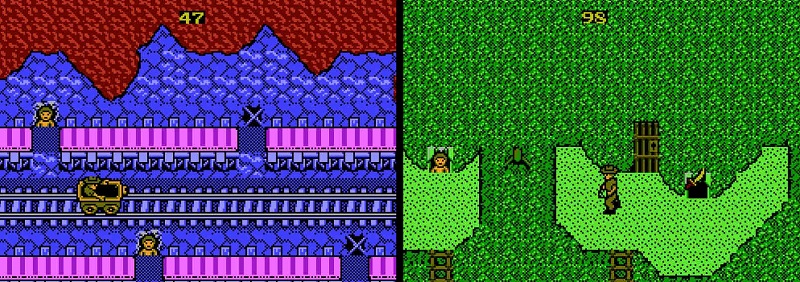
The Thuggee cult members who chase you around the screen don’t die. As in Fate of Atlantis: The Action Game they faint for a short time until you can escape, granting you some points. In Temple, though, they at least don’t block your path so you can actually run away. The whip not only hits enemies but also unlocks the children’s cages, and lets you swing across gaps in the platforms. It’s a fun and classic Indy move and a function which will continue in future Indy games. It’s a bit difficult to aim and whip diagonally, requiring you to move as you do so, but that’s forgivable for the era. It also feels fair. Baddies get KO’d if they fall off a ledge, just as you do, likewise if you fall onto or swing across a gap into one of them, giving you a chance to continue. I fully expected to lose a life whenever I touched them, so that was a nice surprise.
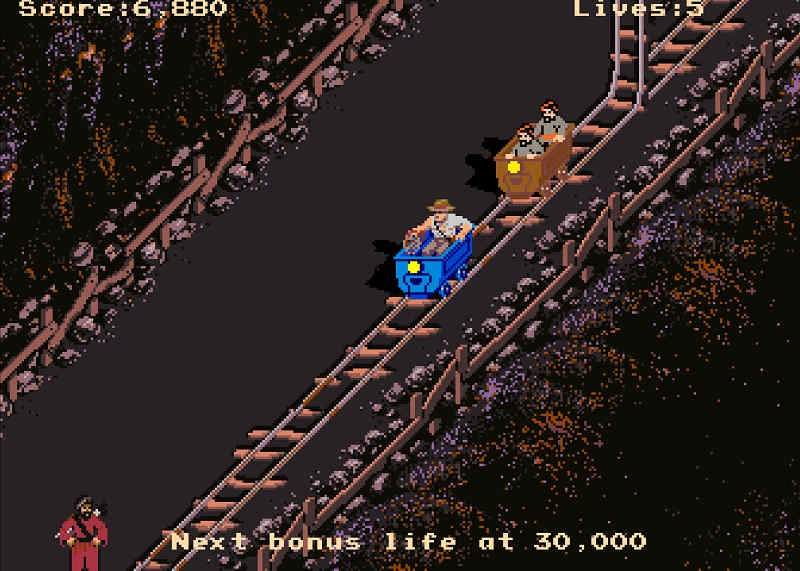
There is some nuance as well, compared to the Raiders Atari game. One wrong move sees you fall off the ledges, losing a life, and in the DOS version a fate worse than losing a life: hearing a screeching simulated Indiana Jones scream bursting through your speakers. However, in order to open the cages you will have to carefully manoeuvre around the ledges in order to whip the locks while avoiding enemies. These levels are somewhat of a maze, but you could also run straight to the end of the level, sacrificing points (and children). It plays a bit like BurgerTime, You are under constant pressure with the re-awakening enemies (and possibly continuously spawning as well, I couldn’t tell), so you will have to make judgement calls as to whether to work your way back through the level to find the remaining captives, or to leave them behind and make Mola Ram happy.
It feels responsive and dynamic in a way 80s games often don’t, and neither the controls nor graphics get in the way of you taking on the challenge of the game as it was meant to be. The Atari version of Temple of Doom is the most enjoyable 2D Indy platformer out there.
